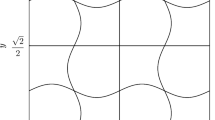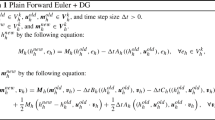Abstract
A rezoning-type adaptive moving mesh discontinuous Galerkin method is proposed for the numerical solution of the shallow water equations with non-flat bottom topography. The well-balance property is crucial to the simulation of perturbation waves over the lake-at-rest steady state such as waves on a lake or tsunami waves in the deep ocean. To ensure the well-balance and positivity-preserving properties, strategies are discussed in the use of slope limiting, positivity-preservation limiting, and data transferring between meshes. Particularly, it is suggested that a DG-interpolation scheme be used for the interpolation of both the flow variables and bottom topography from the old mesh to the new one and after each application of the positivity-preservation limiting on the water depth, a high-order correction be made to the approximation of the bottom topography according to the modifications in the water depth. Mesh adaptivity is realized using a moving mesh partial differential equation and a metric tensor based on the equilibrium variable and water depth. A motivation for the latter is to adapt the mesh according to both the perturbations of the lake-at-rest steady state and the water depth distribution. Numerical examples in one and two spatial dimensions are presented to demonstrate the well-balance and positivity-preserving properties of the method and its ability to capture small perturbations of the lake-at-rest steady state. They also show that the mesh adaptation based on the equilibrium variable and water depth give more desirable results than that based on the commonly used entropy function.






























Similar content being viewed by others
References
Arpaia, L., Ricchiuto, M.: r-adaptation for shallow water flows: conservation, well balancedness, efficiency. Comput. Fluids 160, 175–203 (2018)
Alcrudo, F., Benkhaldoun, F.: Exact solutions to the Riemann problem of the shallow water equations with a bottom step. Comput. Fluids 30, 643–671 (2001)
Audusse, E., Bouchut, F., Bristeau, M.-O., Klein, R., Perthame, B.: A fast and stable well-balanced scheme with hydrostatic reconstruction for shallow water flows. SIAM J. Sci. Comput. 25, 2050–2065 (2004)
Bermudez, A., Vazquez, M.E.: Upwind methods for hyperbolic conservation laws with source terms. Comput. Fluids 23, 1049–1071 (1994)
Cheng, J., Shu, C.-W.: A high order ENO conservative Lagrangian type scheme for the compressible Euler equations. J. Comput. Phys. 227, 1567–1596 (2007)
Cockburn, B., Shu, C.-W.: TVB Runge-Kutta local projection discontinuous Galerkin finite element method for conservation laws II: General framework. Math. Comp. 52, 411–435 (1989)
Cockburn, B., Lin, S.-Y., Shu, C.-W.: TVB Runge-Kutta local projection discontinuous Galerkin finite element method for conservation laws III: one dimensional systems. J. Comput. Phys. 84, 90–113 (1989)
Cockburn, B., Shu, C.-W.: The Runge-Kutta discontinuous Galerkin method for conservation laws V: multidimensional systems. J. Comput. Phys. 141, 199–224 (1998)
Cockburn, B., Shu, C.-W.: Runge-Kutta discontinuous Galerkin methods for convection dominated problems. J. Sci. Comput. 16, 173–261 (2001)
Chinnayya, A., LeRoux, A., Seguin, N.: A well-balanced numerical scheme for the approximation of the shallow-water equations with topography: the resonance phenomenon. Int. J. Finite 1, 1–33 (2004)
Donat, R., Martí, M.C., Martínez-Gavara, A., Mulet, P.: Well-balanced adaptive mesh refinement for shallow water flows. J. Comput. Phys. 257, 937–953 (2014)
Eskilsson, C., Sherwin, S.J.: A triangular spectral/hp discontinuous Galerkin method for modelling 2D shallow water equations. Int. J. Numer. Meth. Fluids 45, 605–623 (2004)
Ern, A., Piperno, S., Djadel, K.: A well-balanced Runge-Kutta discontinuous Galerkin method for the shallow-water equations with flooding and drying. Int. J. Numer. Meth. Fluids 58, 1–25 (2008)
Goodman, J.B., LeVeque, R.J.: On the accuracy of stable schemes for 2D scalar conservation laws. Math. Comp. 45, 15–21 (1985)
Huang, W., Ren, Y., Russell, R.: Moving mesh methods based on moving mesh partial differential equations. J. Comput. Phys. 113, 279–290 (1994)
Huang, W., Ren, Y., Russell, R.: Moving mesh partial differential equations (MMPDEs) based upon the equidistribution principle. SIAM J. Numer. Anal. 31, 709–730 (1994)
Huang, W.: Variational mesh adaptation: isotropy and equidistribution. J. Comput. Phys. 174, 903–924 (2001)
Huang, W., Sun, W.: Variational mesh adaptation II: error estimates and monitor functions. J. Comput. Phys. 184, 619–648 (2003)
Huang, W.: Mathematical principles of anisotropic mesh adaptation. Comm. Comput. Phys. 1, 276–310 (2006)
Huang, W., Russell, R.: Adaptive Moving Mesh Methods. Applied Mathematical Sciences Series. Springer: New York 174, (2011)
Huang, W., Kamenski, L.: A geometric discretization and a simple implementation for variational mesh generation and adaptation. J. Comput. Phys. 301, 322–337 (2015)
Huang, W., Kamenski, L.: On the mesh nonsingularity of the moving mesh PDE method. Math. Comp. 87, 1887–1911 (2018)
Liu, X.-D., Osher, S.: Non-oscillatory high order accurate self similar maximum principle satisfying shock capturing schemes. SIAM J. Numer. Anal. 33, 760–779 (1996)
Lamby, P., Müller, S., Stiriba, Y.: Solution of shallow water equations using fully adaptive multiscale schemes. Int. J. Numer. Meth. Fluids 49, 417–437 (2005)
LeVeque, R.: Balancing source terms and flux gradients in high-resolution Godunov methods: the quasi-steady wave-propagation algorithm. J. Comput. Phys. 146, 346–365 (1998)
Li, R., Tang, T.: Moving mesh discontinuous Galerkin method for hyperbolic conservation laws. J. Sci. Comput. 27, 347–363 (2006)
Li, G., Song, L., Gao, J.: High order well-balanced discontinuous Galerkin methods based on hydrostatic reconstruction for shallow water equations. J. Comput. App. Math. 340, 546–560 (2018)
Luo, D., Huang, W., Qiu, J.: A quasi-Lagrangian moving mesh discontinuous Galerkin method for hyperbolic conservation laws. J. Comput. Phys. 396, 544–578 (2019)
Li, G., Lu, C., Qiu, J.: Hybrid well-balanced WENO schemes with different indicators for shallow water equations. J. Sci. Comput. 51, 527–559 (2012)
Mavriplis, D., Yang, Z.: Construction of the discrete geometric conservation law for high-order time-accurate simulations on dynamic meshes. J. Comput. Phys. 213, 557–573 (2006)
Mavriplis, D., Nastase, C.: On the geometric conservation law for high-order discontinuous Galerkin discretizations on dynamically deforming meshes. J. Comput. Phys. 230, 4285–4300 (2011)
Noelle, S., Xing, Y., Shu, C.-W.: High-order well-balanced finite volume WENO schemes for shallow water equation with moving water. J. Comput. Phys. 226, 29–58 (2007)
Remacle, J.-F., Frazao, S.S., Li, X., Shephard, M.: Adaptive discontinuous Galerkin method for the shallow water equations. Int. J. Numer. Meth. Fluids 52, 903–923 (2006)
Ricchiuto, M., Bollermann, A.: Stabilized residual distribution for shallow water simulations. J. Comput. Phys. 228, 1071–1115 (2009)
Tang, H., Tang, T.: Adaptive mesh methods for one- and two-dimensional hyperbolic conservation laws. SIAM J. Numer. Anal. 41, 487–515 (2003)
Tang, H.: Solution of the shallow-water equations using an adaptive moving mesh method. Int. J. Numer. Meth. Fluids 44, 789–810 (2004)
Tumolo, G., Bonaventura, L., Restelli, M.: A semi-implicit, semi-lagrangian, p-adaptive discontinuous Galerkin method for the shallow water equations. J. Comput. Phys. 232, 46–67 (2013)
Xing, Y., Shu, C.-W.: High order finite difference WENO schemes with the exact conservation property for the shallow water equations. J. Comput. Phys. 208, 206–227 (2005)
Xing, Y., Shu, C.-W.: High order well-balanced finite volume WENO schemes and discontinuous Galerkin methods for a class of hyperbolic systems with source terms. J. Comput. Phys. 214, 567–598 (2006)
Xing, Y., Shu, C.-W.: A new approach of high order well-balanced finite volume WENO schemes and discontinuous Galerkin methods for a class of hyperbolic systems with source terms. Comm. Comput. Phys. 1, 100–134 (2006)
Xing, Y., Zhang, X., Shu, C.-W.: Positivity-preserving high order well-balanced discontinuous Galerkin methods for the shallow water equations. Adv. Water Resourc. 33, 1476–1493 (2010)
Xing, Y., Zhang, X.: Positivity-preserving well-balanced discontinuous Galerkin methods for the shallow water equations on unstructured triangular meshes. J. Sci. Comput. 57, 19–41 (2013)
Xing, Y.: Exactly well-balanced discontinuous Galerkin methods for the shallow water equations with moving water equilibrium. J. Comput. Phys. 257, 536–553 (2014)
Zhang, M., Cheng, J., Huang, W., Qiu, J.: An adaptive moving mesh discontinuous Galerkin method for the radiative transfer equation. Comm. Comput. Phys. 27, 1140–1173 (2020)
Zhang, M., Huang, W., Qiu, J.: High-order conservative positivity-preserving DG-interpolation for deforming meshes and application to moving mesh DG simulation of radiative transfer. SIAM J. Sci. Comput. 42, A3109–A3135 (2020)
Zhang, Z., Naga, A.: A new finite element gradient recovery method: Superconvergence property. SIAM J. Sci. Comput. 26, 1192–1213 (2005)
Zhou, F., Chen, G., Noelle, S., Guo, H.: A well-balanced stable generalized Riemann problem scheme for shallow water equations using adaptive moving unstructured triangular meshes. Int. J. Numer. Meth. Fluids 73, 266–283 (2013)
Zhou, J.G., Causon, D.M., Mingham, C.G., Ingram, D.M.: The surface gradient method for the treatment of source terms in the shallow-water equations. J. Comput. Phys. 168, 1–25 (2001)
Zhang, X., Shu, C.-W.: On positivity preserving high order discontinuous Galerkin methods for compressible Euler equations on rectangular meshes. J. Comput. Phys. 229, 8918–8934 (2010)
Zhang, X., Xia, Y., Shu, C.-W.: Maximum-principle-satisfying and positivity-preserving High Order discontinuous Galerkin schemes for conservation Laws on Triangular Meshes. J. Sci. Comput. 50, 29–62 (2012)
Author information
Authors and Affiliations
Corresponding author
Additional information
Publisher's Note
Springer Nature remains neutral with regard to jurisdictional claims in published maps and institutional affiliations.
M. Zhang and J. Qiu were supported partly by National Natural Science Foundation (China) grant 12071392 and Science Challenge Project (China), No. TZ 2016002 . This work was carried out while M. Zhang was visiting the Department of Mathematics, the University of Kansas under the support by the China Scholarship Council (CSC: 201806310065).
Rights and permissions
About this article
Cite this article
Zhang, M., Huang, W. & Qiu, J. A High-Order Well-Balanced Positivity-Preserving Moving Mesh DG Method for the Shallow Water Equations With Non-Flat Bottom Topography. J Sci Comput 87, 88 (2021). https://doi.org/10.1007/s10915-021-01490-3
Received:
Revised:
Accepted:
Published:
DOI: https://doi.org/10.1007/s10915-021-01490-3
Keywords
- Well-balance
- DG-interpolation
- High-order
- Positivity preservation
- Moving mesh DG method
- Shallow water equations




